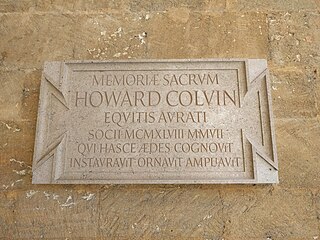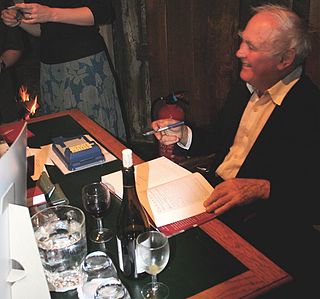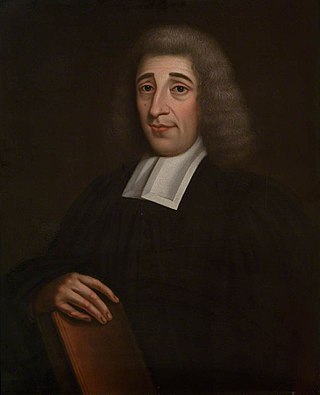Related Research Articles
William Wilkins was an English architect, classical scholar and archaeologist. He designed the National Gallery and University College London, and buildings for several Cambridge colleges.

Thomas Rickman was an English architect and architectural antiquary who was a major figure in the Gothic Revival. He is particularly remembered for his Attempt to Discriminate the Styles of English Architecture (1817), which established the basic chronological classification and terminology that are still in widespread use for the different styles of English medieval ecclesiastical architecture.

James Gibbs was a Scottish architect. Born in Aberdeen, he trained as an architect in Rome, and practised mainly in England. He is an important figure whose work spanned the transition between English Baroque architecture and Georgian architecture heavily influenced by Andrea Palladio. Among his most important works are St Martin-in-the-Fields, the cylindrical, domed Radcliffe Camera at Oxford University, and the Senate House at Cambridge University.
Sir John Newenham Summerson was one of the leading British architectural historians of the 20th century.
Christopher Edward Clive Hussey CBE was a British architecture writer. He was one of the chief authorities on British domestic architecture of the generation that also included Dorothy Stroud and Sir John Summerson.

Sir Howard Montagu Colvin was a British architectural historian who produced two of the most outstanding works of scholarship in his field: A Biographical Dictionary of British Architects, 1600–1840 and The History of the King's Works.
Ptolemy Hugo Dean is a British architect, television presenter and the 19th Surveyor of the Fabric of Westminster Abbey. He specialises in historic preservation, as well as designing new buildings that are in keeping with their historic or natural settings. He is best known for his appearances on two BBC television series, Restoration and The Perfect Village.
Henry-Russell Hitchcock was an American architectural historian, and for many years a professor at Smith College and New York University. His writings helped to define the characteristics of modernist architecture.
Vaughan Hart is a leading architectural historian, and Professor Emeritus of Architecture in the Department of Architecture and Civil Engineering at the University of Bath. He served as head of department between 2008 and 2010.

Joseph Mordaunt Crook,, generally known as J. Mordaunt Crook, is an English architectural historian and specialist on the Georgian and Victorian periods. He is an authority on the life and work of the Victorian architect William Burges, his biography published in 1981, and reissued in 2013, has been described as "one of the most substantial studies of any Victorian architect".

John Frederick Harris OBE was an English curator, historian of architecture, gardens and architectural drawings, and the author of more than 25 books and catalogues, and 200 articles. He was a Fellow and Curator Emeritus of the Drawings Collection of the Royal Institute of British Architects, founding Trustee of Save Britain's Heritage and Save Europe's Heritage, and founding member and Honorary Life President of the International Confederation of Architectural Museums.
Timothy Mowl FSA is an architectural and landscape historian. He is Emeritus Professor of History of Architecture and Designed Landscapes at the University of Bristol, and Honorary Professor at the Royal Agricultural University, Cirencester. He is also Director of AHC Consultants. He was awarded the Hawksmoor Medal of the Society of Architectural Historians of Great Britain in 1987, was elected a Fellow of the Society of Antiquaries of London in 1993, and served as a member of Council of the Garden History Society between 2002 and 2007. He is currently President of the Avon Gardens Trust.
Giles Arthington Worsley was an English architectural historian, author, editor, journalist and critic, specialising in British country houses. He was the second son of Sir Marcus Worsley, 5th Baronet, of Hovingham Hall, a nephew of Katharine, Duchess of Kent, and died of cancer aged 44.

Sir James Burrough was an English academic, antiquary, and amateur architect. He was Master of Gonville and Caius College, Cambridge, and designed or refaced several of the buildings at Cambridge University in a Classical style.
James Essex (1722–1784) was an English builder and architect who mostly worked in Cambridge, where he was born. He designed portions of many colleges of the University of Cambridge, and carried out major restorations of the cathedrals at Ely and Lincoln. He was an admirer of Gothic architecture, and assembled materials for a history of the style, though the book remained unpublished.
John Carter (1748–1817) was an English draughtsman and architect, who was an early advocate of the revival of Gothic architecture.
Dell Thayer Upton is an architectural historian. He is emeritus professor at the department of art history at University of California, Los Angeles, and Professor Emeritus of Architecture at the University of California, Berkeley. He had taught previously at the University of Virginia.
Kerry John Downes was an English architectural historian whose speciality was English Baroque architecture. He was Professor of History of Art, University of Reading, 1978–91, then Emeritus.
Peter Draper is an English architectural historian. He has specialised in medieval architecture with a particular interest in English ecclesiastical building, primarily cathedrals, and the relationship between the architecture and its social, political and liturgical functions. Latterly his research has extended to Islamic architecture and its influence on Western traditions. He is Professor emeritus and an honorary life member of Birkbeck College, University of London where he is currently visiting professor in the History of Architecture. He has published numerous articles and books including The Formation of English Gothic : Architecture and Identity, for which he won two prestigious awards; the Spiro Kostof Book Award from the Society of Architectural Historians in 2008 and the Alice Davis Hitchcock Medallion in 2009, awarded by the Society of Architectural Historians of Great Britain.
References
- ↑ Who's Who. Bloomsbury. 2018.
- ↑ "The Master and Fellows of St John's College".
- ↑ "Fellows Directory of the Society of Antiquaries".
- ↑ "Trustees". www.soane.org. 6 August 2015. Retrieved 14 February 2021.
- ↑ "Historic England Advisory Committee: Membership".
- ↑ "Hawksmoor Essay Medal". Archived from the original on 1 April 2020. Retrieved 20 August 2017.
- ↑ "Sprio Kostof Book Award Recipients" (PDF). Retrieved 20 August 2017.
- ↑ "Revealed: the Houses of Parliament that never came to be". History Extra.
- ↑ "William Kent's Designs for the Houses of Parliament".
- ↑ Armstrong, Christopher Drew (2002). "Review". Journal of the Society of Architectural Historians. 61 (2): 222–224. JSTOR 991845.
- ↑ Miele, Chris (2009). "Review: Summerson and Hitchcock: Centenary Essays on Architectural Historiography (Studies in British Art 16) by Frank Salmon". The Burlington Magazine. 151 (1271): 111.